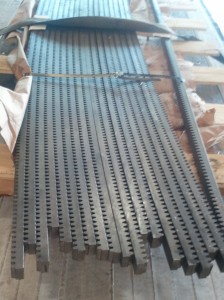Manufacturers continually strive to reduce the costs of their products and that certainly is the case with gear manufacturers. There are several ways to make large ring gears.
A ring can be burned out of plate and then the “teeth” can be cut in a machining operation. Alternately, steel bar can be rolled into a steel ring, welded and then machined. Depending on the size of the gear, one method or the other might have less material loss. A ring cut out of plate might have a large loss of material from the removal of the center ring. Unless this circle can be used for other parts, this steel will be scrapped. Under these circumstances, there would be less material waste by rolling bar into a ring.
A third way to make a gear is to start with stock gear rack–a straight bar with the teeth already cut–and then to roll it into a ring or ring segment. Companies like Boston Gear and Martin Sprocket and Gear sell stock 8ft lengths of gear rack.
Obviously, the pitch or distance between teeth will change when curving stock gear rack, but as long as the radius curvature is large and the pinion gear is kept small (so only a few teeth engage), it will work. This method saved thousands of dollars and months of lead time for one conveyor fabricator. It uses this curved gear rack for a track welder that travels along a curved tank. The racks are curved both “teeth in” and “teeth out.”










